Navigation
Marmot Dam, Oregon’s largest dam, is being removed: salmon and wildlife habitat and public recreation to benefit
A blast of explosives cracked the concrete face of Marmot Dam on the Sandy River on July 24, 2007, beginning its demolition and ushering in a new era for Oregon’s Sandy River Basin.
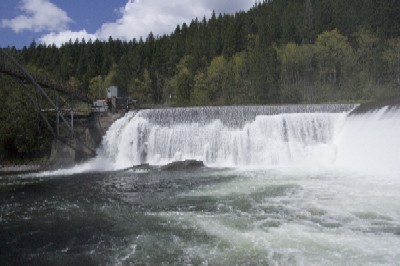 |
| Marmot Dam, 50 feet in height, was built in 1913 to help supply needs as part of the larger Bull Run hydro project begun in 1906 by the Mt. Hood Company. |
A blast of explosives cracked the concrete face of Marmot Dam on the Sandy River on July 24, 2007, beginning its demolition and ushering in a new era for Oregon’s Sandy River Basin.
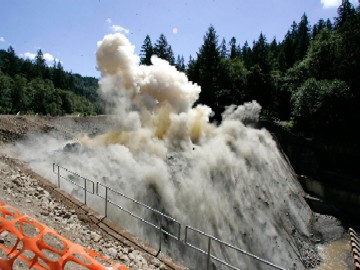 |
| The Dam Explodes. |
Following the detonation, heavy equipment began taking apart the concrete structure. Demolition of the Marmot Dam should take about two months.
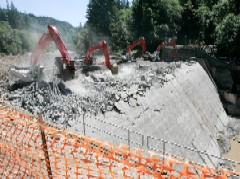 |
| Demolition Shovels: Crews continue the work of demolition after the explosion. |
The concrete chunks will be recycled for road surfacing.
The removal will improve salmon and wildlife habitat and public recreation. The Sandy River is home to winter steelhead, spring Chinook and Coho salmon, all listed as threatened under the federal Endangered Species Act. The State of Oregon lists coho as an endangered species.
The Marmot Dam demolition will be the largest dam removal in the Pacific Northwest in 40 years and the largest ever in Oregon. It is the first phase in Portland General Electric’s $17 million Bull Run Hydroelectric Project “decommissioning” plan, developed in consensus with 23 diverse organizations (see list below). They committed to a collaborative agreement, rejecting the expensive and exhaustive adversarial proceedings that characterize many major environmental decisions.
The plan also provides for the removal of PGE’s Little Sandy Dam, on its namesake river next summer, followed by the removal of most other project components. The plan has been approved by the Federal Energy Regulatory Commission (FERC). During that work, the river bypasses Marmot Dam, diverted by earthen coffer dams. The coffer dams will be washed away in late autumn by natural stream flows.
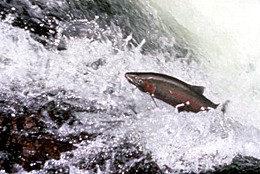 |
| Salmon: Fish will have access to about 100 miles of stream habitat above the dam. |
This partnership took a great step toward restoring a breathtaking river for fish, wildlife and people,” said Peggy Fowler, PGE Chief Executive Officer (CEO) and President. “We celebrate the future of a watershed that will provide unimpeded salmon and steelhead passage from the slopes of Mt. Hood to the Pacific Ocean.”
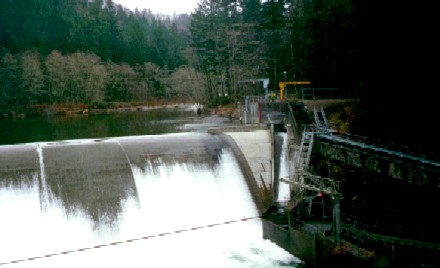 |
| Marmot Dam and its diversion canal, 1987. PGE will maintain fish passage on the Sandy during dam removal, assisting fish if necessary. |
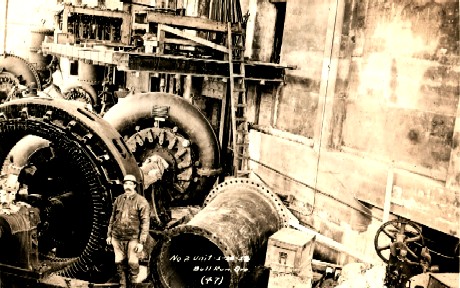 |
| Worker standing beside the No.2 unit, 1912. In 1912, the Bull Run Project was taken over by the Portland Railway Light & Power Company. |
Located about 40 miles east of Portland, the structure was built in 1913 to power a trolley that carried city dwellers out to the countryside and was rebuilt in 1989 after a flood.
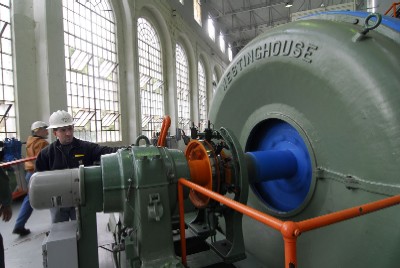 |
| Bull Run Power House with Crew |
At 22 megawatts, Bull Run is one of PGE’s smallest generating facilities, and its power has already been replaced with environmentally friendly wind power and other sources.
PGE is surrendering its rights to the water “in stream,” meaning no one can remove that amount of water in the future.
PGE, headquartered in Portland, also will donate 1,500 acres of its Sandy River Basin land to the Western Rivers Conservancy, which will convey most of the property to the U.S. Bureau of Land Management for permanent protection. The land will form the foundation of a planned 9,000-acre conservation and recreation area. The Sandy will remain one of the top Chinook salmon and steelhead fishing destinations in Oregon, while Marmot Dam removal will enhance whitewater rafting and kayaking on the river.
PGE announced that it would remove the Bull Run Hydroelectric Project in 1999 after the company determined that demolition would be more economical for its customers than maintaining the facility and upgrading it to modern fish protection standards. PGE remains committed to hydropower and is in the process of upgrading fish protection at its remaining hydro projects.
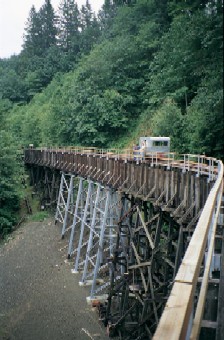 |
| The elevated wood box flume at Bull Run will be removed in 2008. |
Next summer’s demolition of the 16-foot-high Little Sandy Dam will allow fish passage at that location for the first time in almost a century. The structure currently diverts almost all of the water out of the lower Little Sandy River for power production. More than 10 miles of habitat will be restored when the natural flows are restored to the Little Sandy River.
For more information, photos, video and updates, visit the Marmot Dam Web site.
The information for this article was provided by PGE.
Photographs: Portland General Electric
Note: Portland General Electric, headquartered in Portland, Ore., is a fully integrated electric utility that serves more than 796,000 residential, commercial and industrial customers in Oregon.
For more information contact Mark Fryburg, PGE, (1) 503-464-8481. Mark.Fryburg@pgn.com
Partner organizations:
Alder Creek Kayak Supply, Inc.
Northwest Sportfishing Industry Assoc.
National Marine Fisheries Service
Oregon Council of Trout Unlimited
Oregon Dept. of Environmental Quality
Oregon Dept. of Fish and Wildlife
Sandy River Basin Watershed Council
U.S. Bureau of Land Management
Photos:
http://www.marmotdam.com/genphoto_files/generalphotos.html
Videos:
Overview of the Coffer dam construction
Search
Latest articles
Agriculture
- World Water Week: Healthy ecosystems essential to human health: from coronavirus to malnutrition Online session Wednesday 24 August 17:00-18:20
- World Water Week: Healthy ecosystems essential to human health: from coronavirus to malnutrition Online session Wednesday 24 August 17:00-18:20
Air Pollution
- "Water and Sanitation-Related Diseases and the Changing Environment: Challenges, Interventions, and Preventive Measures" Volume 2 Is Now Available
- Global Innovation Exchange Co-Created by Horizon International, USAID, Bill and Melinda Gates Foundation and Others
Biodiversity
- It is time for international mobilization against climate change
- World Water Week: Healthy ecosystems essential to human health: from coronavirus to malnutrition Online session Wednesday 24 August 17:00-18:20
Desertification
- World Water Week: Healthy ecosystems essential to human health: from coronavirus to malnutrition Online session Wednesday 24 August 17:00-18:20
- UN Food Systems Summit Receives Over 1,200 Ideas to Help Meet Sustainable Development Goals
Endangered Species
- Mangrove Action Project Collaborates to Restore and Preserve Mangrove Ecosystems
- Coral Research in Palau offers a “Glimmer of Hope”
Energy
- Global Innovation Exchange Co-Created by Horizon International, USAID, Bill and Melinda Gates Foundation and Others
- Wildlife Preservation in Southeast Nova Scotia
Exhibits
- Global Innovation Exchange Co-Created by Horizon International, USAID, Bill and Melinda Gates Foundation and Others
- Coral Reefs
Forests
- NASA Satellites Reveal Major Shifts in Global Freshwater Updated June 2020
- Global Innovation Exchange Co-Created by Horizon International, USAID, Bill and Melinda Gates Foundation and Others
Global Climate Change
- It is time for international mobilization against climate change
- It is time for international mobilization against climate change
Global Health
- World Water Week: Healthy ecosystems essential to human health: from coronavirus to malnutrition Online session Wednesday 24 August 17:00-18:20
- More than 400 schoolgirls, family and teachers rescued from Afghanistan by small coalition
Industry
- "Water and Sanitation-Related Diseases and the Changing Environment: Challenges, Interventions, and Preventive Measures" Volume 2 Is Now Available
- Global Innovation Exchange Co-Created by Horizon International, USAID, Bill and Melinda Gates Foundation and Others
Natural Disaster Relief
- STOP ATTACKS ON HEALTH CARE IN UKRAINE
- Global Innovation Exchange Co-Created by Horizon International, USAID, Bill and Melinda Gates Foundation and Others
News and Special Reports
- World Water Week: Healthy ecosystems essential to human health: from coronavirus to malnutrition Online session Wednesday 24 August 17:00-18:20
- STOP ATTACKS ON HEALTH CARE IN UKRAINE
Oceans, Coral Reefs
- World Water Week: Healthy ecosystems essential to human health: from coronavirus to malnutrition Online session Wednesday 24 August 17:00-18:20
- Mangrove Action Project Collaborates to Restore and Preserve Mangrove Ecosystems
Pollution
- Zakaria Ouedraogo of Burkina Faso Produces Film “Nzoue Fiyen: Water Not Drinkable”
- "Water and Sanitation-Related Diseases and the Changing Environment: Challenges, Interventions, and Preventive Measures" Volume 2 Is Now Available
Population
- "Water and Sanitation-Related Diseases and the Changing Environment: Challenges, Interventions, and Preventive Measures" Volume 2 Is Now Available
- "Water and Sanitation-Related Diseases and the Changing Environment: Challenges, Interventions, and Preventive Measures" Volume 2 Is Now Available
Public Health
- Honouring the visionary behind India’s sanitation revolution
- Honouring the visionary behind India’s sanitation revolution
Rivers
- World Water Week: Healthy ecosystems essential to human health: from coronavirus to malnutrition Online session Wednesday 24 August 17:00-18:20
- Mangrove Action Project Collaborates to Restore and Preserve Mangrove Ecosystems
Sanitation
- Honouring the visionary behind India’s sanitation revolution
- Honouring the visionary behind India’s sanitation revolution
Toxic Chemicals
- "Water and Sanitation-Related Diseases and the Changing Environment: Challenges, Interventions, and Preventive Measures" Volume 2 Is Now Available
- Actions to Prevent Polluted Drinking Water in the United States
Transportation
- "Water and Sanitation-Related Diseases and the Changing Environment: Challenges, Interventions, and Preventive Measures" Volume 2 Is Now Available
- Urbanization Provides Opportunities for Transition to a Green Economy, Says New Report
Waste Management
- Honouring the visionary behind India’s sanitation revolution
- Honouring the visionary behind India’s sanitation revolution
Water
- Honouring the visionary behind India’s sanitation revolution
- Honouring the visionary behind India’s sanitation revolution
Water and Sanitation
- Honouring the visionary behind India’s sanitation revolution
- Honouring the visionary behind India’s sanitation revolution

